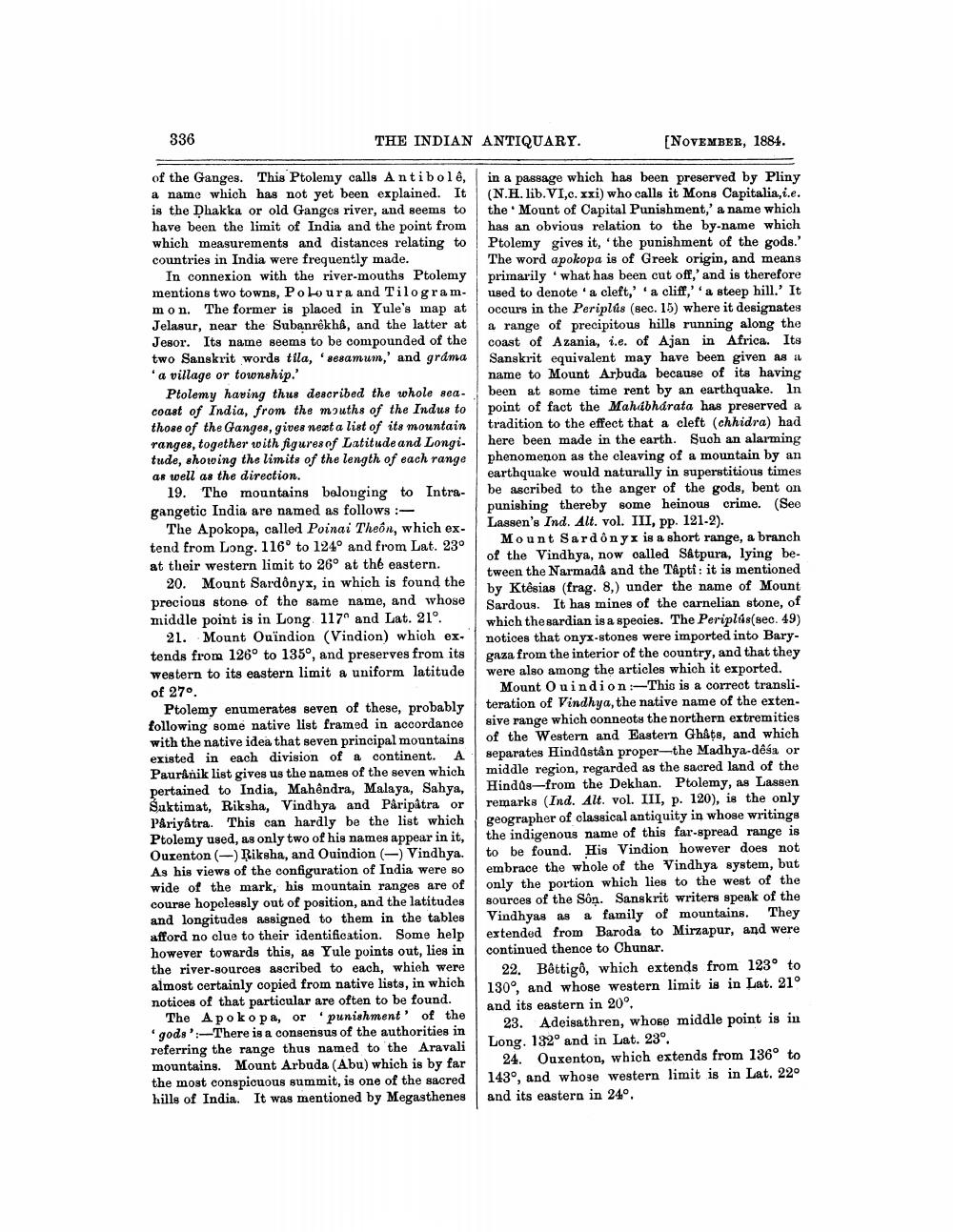________________
336
THE INDIAN ANTIQUARY.
[NOVEMBER, 1884.
of the Ganges. This Ptolemy calls Antibole, a name which has not yet been explained. It is the Dhakka or old Ganges river, and seems to have been the limit of India and the point from which measurements and distances relating to countries in India were frequently made.
In connexion with the river-mouths Ptolemy mentions two towns, Poloura and Tilogrammon. The former is placed in Yule's map at Jelasur, near the Subanrêkha, and the latter at Jesor. Its name seems to be compounded of the two Sanskrit words tila, sesamum,' and grama 'a village or township.'
Ptolemy having thus described the whole sea. coast of India, from the mouths of the Indus to those of the Ganges, gives next a list of its mountain ranges, together with figures of Latitude and Longi. tude, showing the limits of the length of each range as well as the direction.
19. The mountains belonging to Intragangetic India are named as follows :
The Apokopa, called Poinai Theon, which extend from Long. 116° to 124o and from Lat. 23° at their western limit to 26° at the eastern
20. Mount SardÔnyx, in which is found the precious stone of the same name, and whose middle point is in Long 117o and Lat. 21°.
21. Mount Ouindion (Vindion) which ex. tends from 1269 to 1350, and preserves from its western to its eastern limit a uniform latitude of 27°
Ptolemy enumerates seven of these, probably following some native list framed in accordance with the native idea that seven principal mountains existed in each division of a continent. A Pauranik list gives us the names of the seven which pertained to India, Mahendra, Malaya, Sahya, Saktimat, Riksha, Vindhya and Paripåtra or PAriyâtra. This can hardly be the list which Ptolemy used, as only two of his names appear in it, Ouxenton (-) Riksha, and Ouindion (-) Vindhya. As his views of the configuration of India were so wide of the mark, his mountain ranges are of course hopelessly out of position, and the latitudes and longitudes assigned to them in the tables afford no clue to their identification. Some help however towards this, as Yule points out, lies in the river-sources ascribed to each, which were almost certainly copied from native lists, in which notices of that particular are often to be found.
The Apokopa, or punishment of the gods':--There is a consensus of the authorities in referring the range thus named to the Aravali mountains. Mount Arbuda (Abu) which is by far the most conspicuous summit, is one of the sacred hills of India. It was mentioned by Megasthenes
in a passage which has been preserved by Pliny (N.H. lib. VI... xxi) who calls it Mons Capitalia, i.e. the Mount of Capital Punishment,' a name which has an obvious relation to the by-name which Ptolemy gives it, the punishment of the gods.' The word apokopa is of Greek origin, and means primarily what has been cut off,' and is therefore used to denote 'a cleft,' 'a cliff,' 'a steep hill.' It occurs in the Periplús (sec. 15) where it designates a range of precipitous hills running along the coast of Azania, i.e. of Ajan in Africa. Its Sanskrit equivalent may have been given as i name to Mount Arbuda because of its having been at some time rent by an earthquake. In point of fact the Mahabharata has preserved a tradition to the effect that a cleft (chhidra) had here been made in the earth. Such an alarming phenomenon as the cleaving of a mountain by an earthquake would naturally in superstitious times be ascribed to the anger of the gods, bent on punishing thereby some heinous crime. (See Lassen's Ind. Alt. vol. III, pp. 121-2).
Mount Sardonyx is a short range, a branch of the Vindhya, now called Satpura, lying between the Narmada and the Tậptî: it is mentioned by Ktêbias (frag. 8,) under the name of Mount Sardous. It has mines of the carnelian stone, of which thesardian is a species. The Periplas(sec. 49) notices that onyx-stones were imported into Barygaza from the interior of the country, and that they were also among the articles which it exported.
Mount Ouindion :- This is a correct transliteration of Vindhya, the native name of the extensive range which conneots the northern extremities of the Western and Eastern Ghâțe, and which separates Hindástán proper—the Madhya-desa or middle region, regarded as the sacred land of the Hinds-from the Dekhan. Ptolemy, as Lassen remarks (Ind. Alt. vol. III, p. 120), is the only geographer of classical antiquity in whose writings the indigenous name of this far-spread range is to be found. His Vindion however does not embrace the whole of the Vindhya system, but only the portion which lies to the west of the sources of the Sôn. Sanskrit writers speak of the Vindhyas as a family of mountains. They extended from Baroda to Mirzapur, and were continued thence to Chunar.
22. Bêttig, which extends from 123° to 130°, and whose western limit is in Lat. 21° and its eastern in 20o,
23. Adeisathren, whose middle point is in Long. 132o and in Lat. 23o.
24. Ouxenton, which extends from 136° to 143°, and whose western limit is in Lat. 22° and its eastern in 24°




